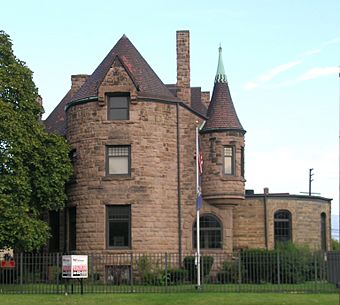William H. Wells House facts for kids
Quick facts for kids |
|
|
William H. Wells House
|
|
 |
|
| Location | 2931 E. Jefferson Ave. Detroit, Michigan |
|---|---|
| Area | less than one acre |
| Built | 1889 |
| Architect | William Henry Miller |
| Architectural style | Romanesque Revival |
| MPS | East Jefferson Avenue Residential TR |
| NRHP reference No. | 85002949 |
| Added to NRHP | October 9, 1985 |
The William H. Wells House is a large, private home located at 2931 East Jefferson Avenue in Detroit, Michigan. This historic house was added to the National Register of Historic Places in 1985. It is known for its unique design and interesting past.
History of the House
This beautiful house was built in 1889. It was designed by a famous architect named William Henry Miller. The Vinton company constructed the building.
The land where the house stands was first owned by the family of William Croul. Soon after it was built, William H. Wells moved in. He was a partner in a law firm. Mr. Wells bought the house in 1900.
After William Wells passed away, his wife sold the house to Ella Barbour. She owned the home until 1949. Later, in 1966, the University of Detroit Alumni Association bought the house. They then gave it to the University of Detroit.
Over the years, the house had several different owners. It was fully updated and restored in the year 2000. In 2015, a company called Banyan Investments LLC bought the property.
Architecture and Design
The William H. Wells House is a very large mansion. It has two and a half stories and is about 18,000 square feet. The house is built in the Romanesque Revival style. This means it looks like old Roman buildings, often with round arches and strong stone.
The house is made of rough, rock-faced stone. It has an unusual shape, with parts sticking out in different places. The main entrance is set into one of these parts. A round tower, called a turret, stands at one corner. It has a cone-shaped roof that curves inward.
Other sections of the house also stick out from the main building. These parts are placed in a way that makes the house look interesting and artistic. In 1891, a separate building was added behind the house. This was a 4,500 square foot carriage house. It was built with red brick and wood siding.
The William H. Wells House is important for two main reasons. First, it is a great example of Romanesque style homes in Detroit. Second, it shows the amazing work of architect William Henry Miller.
See also
 In Spanish: Casa William H. Wells para niños
In Spanish: Casa William H. Wells para niños


